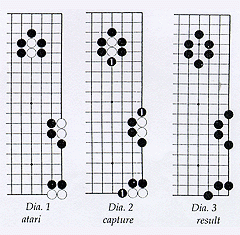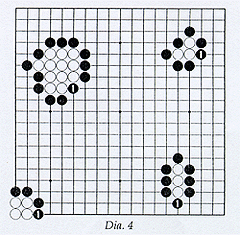Go comes to Japan
Go was probably brought to Japan from Korea by artists, scholars and former officials who migrated to Japan to escape political turmoil in their own land. There are no written records verifying the precise date of go's introduction into Japan, but according to the "Records of the Sui," the chronicle of a Chinese dynasty (597-618), go was one of the three major pastimes enjoyed by early 7th-century Japanese (the other two were backgammon and gambling).In contrast to the documentary evidence from Chinese historical records, the popular belief in Japan is that go was brought directly from China in the year 735 by Kibi no Makibi, popularly known as Grand Minister Kibi. He was sent to the Tang capital of Chang-an with a commission from Emperor Shomu's daughter, who succeeded to her father's throne as the Empress Koken, to bring the best of Tang learning back to Japan. After 18 years in China, Kibi returned with a cargo of artifacts representing his choice of the best of Chinese culture. He also brought back a knowledge of go.
While go was undoubtedly one of many games enjoyed by the upper classes of early 7th-century Japan before Kibi's return from Chang-an, it is probable that when he informed those at the Imperial court of go's popularity at the Tang court, go was elevated to a special status, resulting in its establishment as a game worthy of the Japanese nobility. It is safe to say that while Kibi did not introduce go to Japan, he was responsible for its achieving the great prestige it has enjoyed here.
Six basic rules of go
1. Moves are played on the intersections.2. The stones do not move after being played.
3. Black plays first.
4. Black and White alternate in making their moves.
5. The object of go is to control territory. The winner is the side that controls the more territory at the end of the game.
6. A stone or a group of connected stones is captured if all of its liberties are occupied.
After its introduction into Japan, go was played mainly at the court by nobles, both male and female, by Buddhist clerics, and by members of the military class, who are reputed to have taken their go sets with them to battle so they could play at war after the actual fighting was over.
In "The Tale of Genji," written in the early 11th century by Murasaki Shikibu, an Imprerial court lady, there are passages that show go playing was a common pastime among both male and female aristocrats. One of the scenes from this novel, in which Prince Genji spies on a game between Lady Utsusemi and another woman, has been a popular subject in Japanese art.

Capturing two or more stones
It is possible to capture two or more stones if you can occupy all their liberties. Here are some examples.Diagram 1 shows three positions in which two stones are in atari. Black captures these stones in Diagram 2. Diagram 3 shows the result.
Any number of stones, making up any kind of shape, can be captured if all their liberties are occupied. In Diagram 4, there are four different positions. Black 1 captures 12 stones in the upper left, four stones in the lower left, three stones in the upper right and three stones in the lower right.
 When you capture stones in a game, you remove them from the board. At the end of the game, you place these captured stones inside your opponent's territory. In the next installment, I will show you how this actually works in a game.
When you capture stones in a game, you remove them from the board. At the end of the game, you place these captured stones inside your opponent's territory. In the next installment, I will show you how this actually works in a game.
